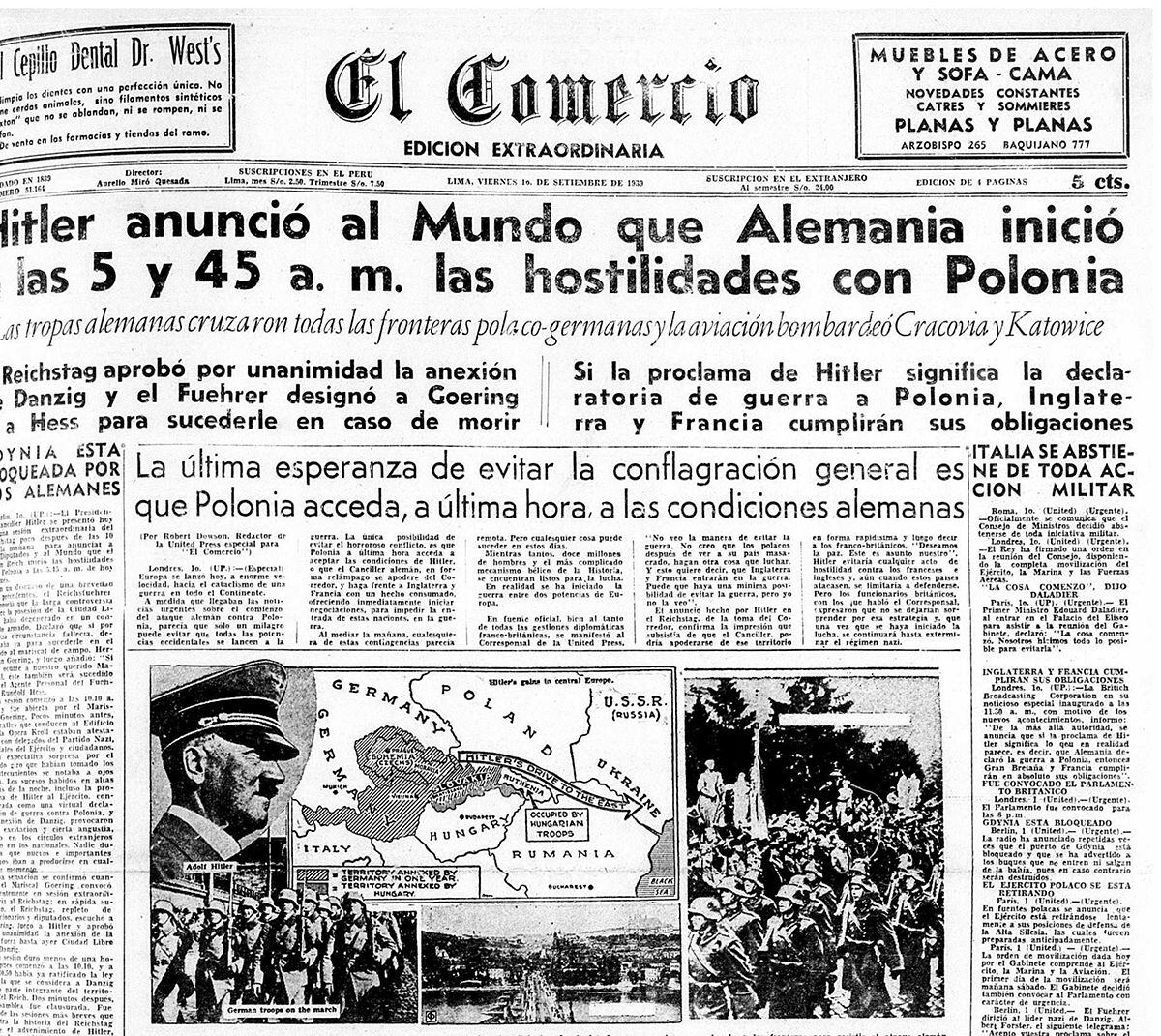In 182 years of journalistic life, El Comercio has reported both remarkable and tragic moments. World War II belonged to the latter. We remember here what happened in Peru in 1939, when the world conflict broke out, and how the dean newspaper reported on this terrible war event through “extraordinary editions”.
On 1939 the news was not delivered”on-line”. But the journalist’s urgency to report was the same as it is these days. He had to transmit the news truthfully, quickly and responsibly.
READ ALSO | “The worst mistake would be to think that Vladimir Putin will settle for Ukraine alone” | INTERVIEW
Along these lines, the dean newspaper created the “extraordinary editions”, copies of a few pages that came out “hot”, the same day that an exceptional piece of news warranted it. He complemented the morning edition and preceded the evening edition; abounding in data and newly arrived dispatches on the great event of the day. This was the case with the beginning of the WWII.
PERU IN 1939
The year the world war began, Peru was experiencing politically agitated circumstances. In February, General Anthony Rodriguez had attempted a coup against the president Oscar R. Benavides. In June, a plebiscite was held to reform the Constitution. And in October the congressional and presidential elections were held, which he won Manuel Prado and Ugarteche.
In February, in addition, we obtained the South American Soccer Championshipand May 4 Trade celebrated its centenary. And on May 14, the Peruvian girl Lina Medina she amazed the world as a mother at the age of five.
SEE ALSO | 30 years after the Iraqi invasion of Kuwait: What effects did it have on Peru?
War in sight!
The German raids began in the early hours of September 1, 1939, Europe time. The time difference allowed the information to reach Lima from the last hours of August 31.

That’s why the morning edition of Trade confirmed the beginning of the combats: “The Germans bomb Warsaw”, said the main headline. Another news item stated:The British government ordered the full mobilization of its regular combat forces”.
the extraordinary edition
Unleashed the conflict, dispatches from the agencies continued to arrive all morning. the manager was Aurelio Miró Quesada of the War. Under these circumstances, editors and journalists began to “put together” another edition with “fresh” information, helped by the typesetter and linotyper of the time.
MORE INFORMATION | The story of the Peruvian diplomat who warned of the Pearl Harbor attack
At noon, Trade already launched his extraordinary edition four pages, to keep your readers and subscribers updated. The headline was blunt: “Hitler announces to the world that Germany has started hostilities against Poland at 5:45 am”.

In the first paragraph the note read:Chancellor Hitler appeared today at an extraordinary session of the Reichstag shortly after 10 a.m. (German time) to announce to deputies and the world that the great Reich began hostilities in Poland at 5:15 a.m. today, Friday.”.
READ ALSO | Peruvian who returned to Lima in 1980, survived the Hiroshima atomic bomb
Unlike the morning edition, the extraordinary edition it had incorporated a map that described the deployment of German troops on Polish territory. In addition, this graph was accompanied by three photos: one from the Polish city of Katowice, bombed that same morning, and another two on the German and Polish armies. Other headlines warned: “German troops cross all Polish-German borders” and “The Reichstag unanimously approved the annexation of Danzig”.

Between 1839 and 1925, Trade had up to 46 extraordinary editions, the majority in the period of the First World War.
From 1926an investigation of Archive confirmed the existence of another hundred editions of this type, basically published during the WWIIor in other momentous events such as the assassination of the president of the United States, John F. Kennedythe November 22, 1963.
DO YOU KNOW OUR VIRTUAL STORE?
In our virtual store we have a selection of the best illustrations, photos and historical pages of El Comercio that you can easily request through a simple form located at the following address: https://www.tiendaelcomercio.com/.
- The last message written by the captain of the Kursk submarine, sunk 20 years ago
- Antonio Rodríguez, the general who died trying to seize power in 1939
- The battle of Tarapacá: 142 years after a victory that raised the morale of Peru
- The history of the Standard of Pizarro given to José de San Martín and that Francisco Bolognesi brought to Peru in 1862
Source: Elcomercio

:quality(75)/cloudfront-us-east-1.images.arcpublishing.com/elcomercio/ELBAZXSWJVA5TB5W6LCWJCZY54.jpg)



:quality(75)/cloudfront-us-east-1.images.arcpublishing.com/elcomercio/X6A7DAY2TFEPBGZZJVXBLABJCM.jpg)
:quality(75)/cloudfront-us-east-1.images.arcpublishing.com/elcomercio/6OL2UIDWNNC6XNSJY3SBYF23YY.jpg)
